Keynote Photonics is currently customizing a state-of-the-art 4K Ultra High Definition (UHD) projector.
Ever wonder what’s inside an Ultra High Definition projector? Here at Keynote Photonics, we have a LOT of experience in digital light processing, specifically Texas Instruments DLP® technology. So we have a pretty good idea of what’s inside any DLP projector. Also, our product mix stretches all the way from DLP dental scanners to DNA sequencers, so we’ve seen a wide range of different applications.
And now we have recently expanded our product line to include a 4K UHD evaluation projector using one of Texas Instruments’ (TI) latest products: the DLP660TE 4K UHD chipset. Originally designed for the high-end home theater market, Keynote’s evaluation version is modified for companies that want to develop their own UHD system.
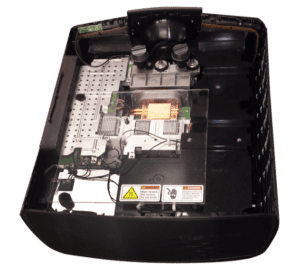
In addition, Keynote is already planning to add features that will extend its capabilities. And here’s the fun part: before we can add new features, we need to understand the complete system. And to understand the complete system, we need to take one completely apart!
Here’s a photo of our evaluation system. The first item of interest is the amount of the ducting in the system. The ducting provides a smooth path for the high-capacity cooling system. This enables the system to keep everything cool while remaining incredibly quiet.
Projecting 2,200 lumens requires some heavy-duty cooling.
Removing the ducting reveals the cooling system for the LED light sources and their power supplies. Most noteworthy, the actual cooling is provided by six large fans coupled to 4 massive heat sinks.
At the front-left of the unit, we removed an EMI shield revealing a long, printed-circuit-board (PCB) covering the system power supply. The PCB contains the entire video front-end including an Mstar ASIC. To the rear of the power supply, is the red LED with double heatsinks to handle the thermal load. Finally, the blue LED and its single heatsink are located at the rear of the unit.
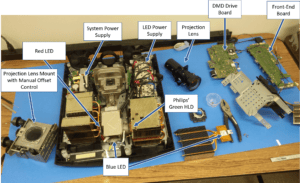
The Philips HLD light source provides plenty of green, allowing the projector to display the entire DCI-P3 color space.
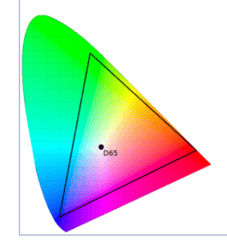


On the right rear of the unit is a massive double-stack heatsink sandwiching the Philips High-Lumen-Density (HLD) Green light source. This green illuminator actually uses high-power blue LEDs firing into optics coated with green phosphor. This combination creates a massive amount of green light. As a result, the projector is able to display the entire DCI-P3 color space.
Although the system already projects a very respectable 2200 lumens, the high-power green produced by Philips ColorSpark® technology means that the picture quality will dwarf other projectors with even higher lumen specifications.
The front right of the system is entirely taken up by the power supply for the LEDs. The Red and Blue LEDs use similar power supplies while the Green HLD illuminator has its own unique power supply.
The design provides a variety of ways to optimize the projected image
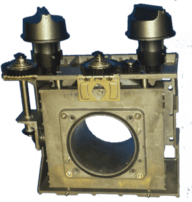


The projection lens and it’s mounting structure are located at the front of the projector. The on-axis projection lens includes a lens shift mechanism for horizontal and vertical positioning of the image. The lens shift is typically set for 100% vertical offset for convenient table placement or ceiling-mount. And the lens itself has two concentric outer rings for user-control of the picture zoom and focus.
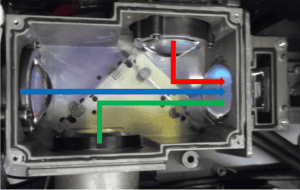


At the very rear of the projector, you can see the illumination optics. Using 1-way reflective dichroic filters, the illumination optics combine the 3 colors and send them into an integrating rod. This integrating rod smooths the light, creating a uniform rectangle of light prior to reaching the DMD.
TI’s DLP® technology is at the heart of the design
Finally, at the very center of the projector is the DMD drive board. This board contains the DLP drive circuitry, the firmware for control of the DLP660TE DMD, and the DMD itself. Because the DMD mounts to the bottom of the board, it can couple directly into the optical system.
The DLP660TE DMD is a WQXGA device containing over 4 million, 5.4 micron mirrors. In addition, near-instantaneous pixel shifting provides over 8 million pixels on the screen for 4K ultra high definition video and other UHD applications.
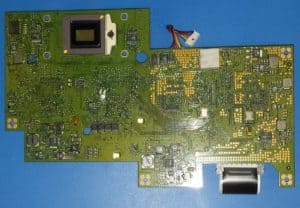


Let us help…
Keynote Photonics is an authorized provider of custom DLP electronics and projection systems. Our systems are currently helping customers develop and produce a variety of solutions for high-resolution display, 3D scanning, 3D printing, and UV exposure.
If you’d like help in developing your own custom product using DLP technology, please contact us.
——————————————————————————————————————
DLP® and the DLP logo are registered trademarks of Texas Instruments
ColorSpark is a trademark of Philips Lighting Holding B.V.